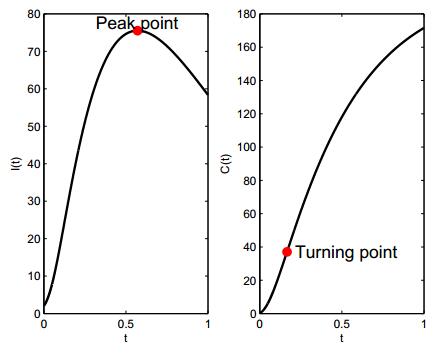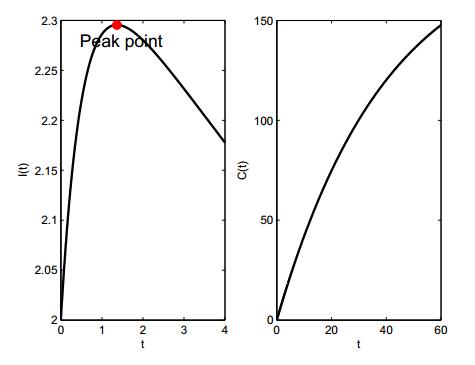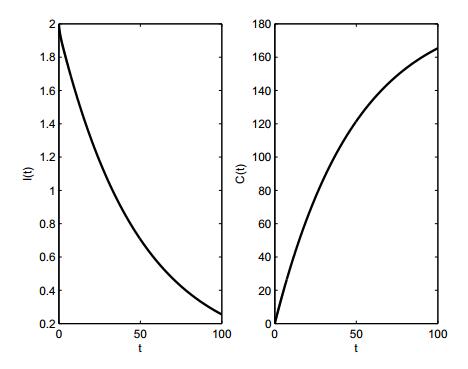The epidemic characteristics of an epidemic model with behavioral change in [V. Capasso, G. Serio, A generalizaition of the Kermack-McKendrick deterministic epidemic model, Math. Bios., 42 (1978), 43-61] are investigated, including the epidemic size, peak and turning point. The conditions on the appearance of the peak state and turning point are represented clearly, and the expressions determining the corresponding time for the peak state and turning point are described explicitly. Moreover, the impact of behavioral change on the characteristics is discussed.
1.
Introduction
It is well-known that the Navier-Stokes equations are the typical evolution equations and widely used in the field of science and engineering. The attractors of Navier-Stokes equations are studied by many scholars in the fields of dynamical systems for a long time (see [1,2,3,4,5,6,7,8,9,10,11,12,13,14,15] and reference therein). Especially in recent years, there are many research achievements on g-Navier-Stokes equation. In [16,17,18], Roh deduced the 2D g-Navier-Stokes equations from 3D Navier-Stokes equations on thin region. It can be viewed as a perturbation of the usual Navier-Stokes equations. Bae et al. studied the well-posedness of weak solution for the 2D g-Navier-Stokes equations. Kwak et al. researched the global attractor and its fractal dimension of 2D g-Navier-Stokes equations in [19]. In [20,21,22,23,24], Jiang et al. studied global and the pullback attractor for g-Navier-Stokes equation. Moreover, the long-time behavior for 2D non-autonomous g-Navier-Stokes equations and the stability of solutions to stochastic 2D g-Navier-Stokes equations were studied by Anh in [25,26], The stationary solutions and its pullback attractor are researched in [27]. On the basis of the above research, we have studied the long time properties for g-Navier-Stokes equation with weakly dampness and time delay in [28] recently.
In this manuscript, the uniform attractor of the g-Navier-Stokes equations with nonlinear dampness is researched. Its usual form is as follows:
In (1.1), we can see that u(t,x)∈R2 and p(t,x)∈R denote the velocity and pressure respectively. ν>0 is the viscosity coefficient, c|u|β−1u denotes nonlinear dampness. c>0 and β≥1 are positive constant. f=f(x,t) is the external force term, 0<m0≤g=g(x1,x2)≤M0 and g=g(x1,x2) is a suitable smooth function, Let c=0 and g=1, the Eq (1.1) will become the usual 2D Navier-Stokes equations.
This manuscript is organized as follows. In Section 2, we recall some basic results of 2D g-Navier-Stokes equations, then we give the concept about process families and uniform attractor. In Section 3, the global well-posedness of weak solutions for 2D g-Navier-Stokes equations with nonlinear dampness is studied. In Section 4, by the energy equation method, the existence of the uniform attractor of 2D g-Navier-Stokes equation with nonlinear dampness is proved on the unbounded domain. In Section 5, the dimension estimation of the uniform attractor in the quasi-periodic case is obtained.
2.
Preliminaries
We assume Ω is a smooth unbounded domian of R2, Let L2(g)=(L2(Ω))2 and we denote (u,v)=∫Ωu⋅νgdx and |⋅|=(⋅,⋅)1/2,u,v∈L2(g). Let H10(g)=(H10(Ω))2, Set
and ||⋅||=((⋅,⋅))1/2,u=(u1,u2),v=(v1,v2)∈H10(g). We denote D(Ω) be the space of C∞ functions with compact support contained in Ω. So we have the following spaces
where Hg and Vg endowed with the inner product and norm of L2(g) and H10(g) respectively.
We assume that there exists λ1>0, such that
This Poincarˊe-type inequality imposes some restrictions on the geometry of the domain Ω.
The g-Laplacian operator is defined as follows:
The first equation of (1.1) can be rewritten as follows:
In [16], g-orthogonal projection and g-Stokes operator are defined respectively by Pg:L2(g)→Hg and Agu=−Pg(1g(∇⋅(g∇u))). Applying the projection Pg on the Eq (2.2), we have the following weak formulation of (1.1).
where bg:Vg×Vg×Vg→R and
we have
Then the formula (2.3) and (2.4) are equivalent to the following functional equations
We denote
From [16,17,19], we have
where B(u)=B(u,u)=Pg(u⋅∇)u is defined by
A family of two parametric maps {Uf(t,τ)}={Uf(t,τ)|t≥τ,τ∈R} is defined in Hg as follows:
The following concepts and conclusions are given from [7]. ∀f∈L∞(R+;V′g), the translation operator is defined in L∞(R+;V′g) as follows.
Obviously
We set Σ={T(h)f(x,s)=f(x,s+h),∀h∈R}, where T(⋅) is the positive invariant semigroups which act on Σ and satify T(h)Σ⊂Σ,∀h≥0 and
Let ρF>0 be constant, Σ⊂{f∈L∞(R+;V′g):||f||L∞(R+;V′g)≤ρF}. For {Uf(t,τ)} with f∈Σ, we call the parameter f as the symbols of the process family {Uf(t,τ)}, and Σ as the symbol space.
Definition 2.1 [7] A family of two-parametric maps {U(t,τ)} is called a process in Hg, if
(1)Uf(t,s)Uf(s,τ)=Uf(t,τ),∀t≥s≥τ,τ∈R,
(2)Uf(τ,τ)=Id,τ∈R.
Let E be the Banach space, B(E) is denoted the set of all bounded sets on E, then
Definition 2.2 [7] A set B0⊂E is said to be uniformly absorbing for the family of processes {Uf(t,τ)},f∈Σ}, if for any τ∈R and each B∈B(E), there exists t0=t0(τ,B)≥τ, such that for all t≥t0,
Definition 2.3 [7] A set P⊂E is said uniformly atttracting set of {Uf(t,τ)},f∈Σ}, if for any τ∈R, there is
Definition 2.4 [7] A closed set AΣ⊂E is said to be the uniform attractor of the family of processes {Uf(t,τ)},f∈Σ}, if
(1) AΣ⊂E is uniformly attractive;
(2) AΣ⊂E is included in any uniformly attracting set A′ of {Uf(t,τ)},f∈Σ}, that is AΣ⊂A′.
3.
The well-posedness of the solution for 2D g-Navier-Stokes equations with nonlinear dampness in unbounded domain
In the section we will prove the well-posedness of the solution for 2D g-Navier-Stokes equations with nonlinear dampness by the Faedo-Galerkin method.
Definition 3.1 Let u0∈Hg,f∈L2Loc(R;V′g), For any τ∈R, u∈L∞(τ,T;Vg)∩L2(τ,T;Vg)∩Lβ+1(τ,T;Lβ+1(Ω)),∀T>τ is called a weak solution of problem (1.1) if it fulfils
ddtu(t)+νAgu(t)+B(u(t))+c|u|β−1u+νR(u(t))=f(x,t)onD′(τ,+∞;V′g),u(τ)=u0.
Theorem 3.1 Let β≥1, f∈L2Loc(R;V′g), Then for every uτ∈Vg, the equations (1.1) have a unique weak solution u(t)=u(t;τ,uτ)∈L∞(τ,T;Vg)∩L2(τ,T;Vg)∩Lβ+1(τ,T;Lβ+1(Ω)), and u(t) is continuously depending on the initial value in Vg.
Proof. Let {wj}j≥1 be the eigenfunctions of −Δ on Ω with homogeneous Dirichlet boundary conditions, Its corresponding eigenvalues are 0<λ1≤λ2≤…, Obviously, {wj}j≥1⊂Vg forms a Hilbert basis in Hg, given uτ∈Vg and f∈L2Loc(R;V′g).
For any positive integer n≥1, we structure the Galerkin approximate solutions as un(t)=un(t;T,uτ), It has the following form
where γn,j(t) is determined from the initial values of the following system of nonlinear ordinary differential equations.
where ⟨⋅⟩ is dual product of Vg and V′g.
According to the results of the initial value problems of ordinary differential equations, we have that there exists a unique local solution of (3.1). In the following, we prove that the time interval of the solution can be extended to [τ,∞).
Using Cauchy's inequality and Young's inequality, we have
where ||⋅||∗ is norm of V′g. We take (3.3) into (3.2) to obtain
That is
By integrating (3.5) from τ to t, we have
For any T>0 and β≥1, we obtain
So un(t)∈L∞(τ,T;Vg). Therefore B(un(t))∈L∞(τ,T;V′g), |un(t)|β−1un(t)∈Lβ+1(τ,T;Lβ+1(Ω)). As a result,
so {u′n(t)} is bounded in L2(τ,T;Vg).
Then we deduce that there is a subsequence in {un(t)}, which is still denoted by {un(t)}. We obtain un(t)∈L2(τ,T;Vg) and u′n(t)∈L2(τ,T;Vg) such that
(i)un(t)→u(t) is weakly ∗ convergent in L∞(τ,T;Vg);
(ii)un(t)→u(t) is weakly convergent in L2(τ,T;Vg);
(iii)|un(t)|β−1un(t)→ξ is weakly convergent in Lβ+1(τ,T;Lβ+1(Ω));
(iv)u′n(t)→u′(t) is weakly convergent in L2(τ,T;Vg);
(v)un(t)→u(t) is strongly convergent in L2(τ,T;Hg);
(vi)un(t)→u(t),ae(x,t)∈Ω×[τ,T].
From Lemma 1.3 of [29], we can see ξ=|u|β−1u. Since ⋃n∈N+span{w1,w2,⋯,wn} is denseness in Vg, Taking the limit n→∞ on both sides of Eq (3.1), we can obtain that u is a weak solution of (1.1).
In the following, the solution is proved to be unique and continuously dependent on initial values. Let u1,u2 be two weak solutions of (1.1) corresponding to the initial values u1τ,u2τ∈Vg, We take u=u1−u2, From (2.3) we have
Using Hölder inequality and Sobolev embedding theorem, we obtain
we have
where C1>0 is any constant.
where α=ν||∇g||∞2m0λ1/21. so
Thus
Let C be a constant and C=α−2λ1(ν−C1−α)>0, then
Therefore
So we prove the continuous dependence on the initial value. When u1τ=u2τ, that is uτ=0, then the uniqueness of the solution holds.
4.
The uniform attractor of 2D g-Navier-Stokes equations with nonlinear dampness in unbounded domain
In the following we have that the family of processes {Uf(t,τ)},f∈Σ is uniformly bounded (w.r.t.f∈Σ) and it has uniform absorbing sets.
Firstly, the existence of uniformly absorbing sets is proved. Taking the inner product of (2.5) with u, we have
Then
For β≥1, we obtain
where γ=1−2|∇g|∞m0λ1/21>0 for sufficiently small |∇g|∞. Using the Gronwall inequality, we have
and from
we have
So
Integrating (4.1) in s from 0 to t, we have
then we know that the family of processes corresponding to u is uniformly bounded, and
is uniformly absorbing set in Hg. Then the following lemma holds.
Lemma 4.1 Let Σ be symbolic space, The process family corresponding to Eq (1.1) is uniformly bounded in L∞(R+;Hg)∩L2(τ,T;Vg) and there is a uniform absorbing set in Hg.
Lemma 4.2 Let τ≥0, uτn be the sequence in Hg that weakly converges to uτ∈Hg, fn∈Σ is the sequence in L∞(R+;V′g) that weakly converges to f, then
(1) For ∀t>τ, Ufn(t,τ)uτn is weakly converges to Uf(t,τ)uτ in Hg;
(2) For ∀T>τ, Ufn(⋅,τ)uτn is weakly converges to Uf(⋅,τ)uτ in L2(τ,T;Vg).
The proof is similar to Lemma 3.2 of [7], so it is omitted.
As we know, when uτn is bounded in Hg, fn⊂Σ, tn→+∞. If {Ufn(tn,τ)uτn} is precompact in Hg, then the family of processes {Uf(t,τ)},f∈Σ is asymptotically compact. So we construct an energy functional [⋅,⋅]:Vg×Vg→R as follows:
Obviously [⋅,⋅] is bilinear and symmetric, and
Let |∇g|∞ be sufficiently small in (4.2), such that |∇g|∞m0λ1/21<14. Hence
Since
Given u=u(t)=Uf(t,τ)uτ,uτ∈Hg,t≥τ≥0, Then we have
That is ∀uτ∈Hg,t≥τ≥0, we obtain
Lemma 4.3 Let {Uf(t,τ)}f∈Σ is the family of processes of Eq (1.1), then {Uf(t,τ)}f∈Σ is uniformly asymptotically compact.
Proof. Let B⊂Hg is bounded, uτn∈B,fn∈Σ and tn∈R+ is satisfied tn→+∞(n→+∞). From Lemma 4.1, we have a constant M(B,τ)>τ and
There exists sufficiently large tn≥M(B,τ), such that Ufn(tn,τ)B⊂B0. then {Ufn(tn,τ)uτn} is weakly precompact in Hg. For w∈B0⊂Hg, we can deduce that Ufns(tns,τ)uτns is weakly convergent to w in Hg. Similarly ∀T>0 and tns≥T+M(B,τ), we obtain Ufns(tns−T,τ)uτns∈B0. The same to wT∈B0, we can take ns, ∀T>0, so we have utns=Ufns(tns−T,τ)uτns is weakly convergent to wT in Hg. According to the definition of process and translation operator, we have
Let gT,ns=T(tns−T)fns, we denote limnsHw as weak limit in Hg, then
thus
Now we will prove
∀T>0, we have wk=UgkT(T,0)wT. When tns≥T+M(B,τ), we obtain
Obviously
From Lemma 4.2, we obtain
So
For
thus
From wk=UgsT(s,0)wT, we have
∀T>0, we have
From w=UgT(T,0)wT, by the Lemma 3.3 of [7] and Lemma 4.2, we can obtain wk→w in Hg. So there exists any sufficiently small ε>0, such that |wk|2≤|w|2+ε. Since
When ε→0, T→∞, we have
Let B⊂Hg be any bounded set, we have
and v∈ωτ,Σ(B) iff there exists a sequence vn∈B,fn∈Σ,tn∈[τ,+∞). When n→∞, we have tn→+∞ and Ufn(tn,τ)vn→v in Hg. When {Uf(t,τ)},f∈Σ} is uniformly asymptotically compact, t→+∞, we have
We will obtain the minimization of the uniform attractor in the following.
Lemma 4.4 Let {Uf(t,τ)},f∈Σ is any the family of processes, B0 is uniformly absorbing set, AΣ=ω0,Σ(B0). then AΣ is contained in any uniform absorbing set of {Uf(t,τ)},f∈Σ.
Proof. ∀τ>0,∀B⊂Hg, Suppose there is another bounded closed set P⊂Hg which satisfies
where AΣ is not contained in the P. We deduce there is at least one v∈AΣ and v∉P. Since v∈AΣ=ω0,F(B0), From the definition of the uniform ω limit set, there is a sequence vn∈B,fn∈Σ,tn∈[τ,+∞), as n→∞, we have tn→+∞, then Ufn(tn,0)vn→v is obtained in Hg. Given ˜vn=Ufn(tn,0)vn, when n→+∞, There must be Ufn(tn,τ)˜vn→v. Let ˜vn∈B, then we obtain v∈P, It is contradiction, so AΣ⊂P.
Theorem 4.1 Let {Uf(t,τ),f∈Σ} is a family of processes of Eq (1.1), Then the process family has a unique compact uniform attractor AΣ⊂Hg. where AΣ=ω0,Σ(B0), B0 is any uniform absorbing set corresponding to a family of processes.
5.
The dimension estimation of the uniform attractor in the quasi-periodical case
When f(x,t)=f(x,w1(t),w2(t),…,wk(t)) is a quasi-periodic function, That is, there exists a set of rational independent real numbers α1,…,αk which satisfies f(x,α1t,…,αit+2π,…,αkt)=f(x,α1t,…,αit,…,αkt)(1≤i≤k). Here w1(t+α1)=w1(t),w2(t+α2)=w2(t),…,wk(t+αk)=wk(t) and α1,α2,…,αk are rational independent.
Let αt=(α1t,…,αkt), α=(α1,…,αk), w(t)=(w1(t),…,wk(t))=[αt+w0]=(αt+w0)mod(2π)k, w0=(w01,…,w0k)∈Tk=[0,2π]k,F(x,w(t))=f(x,t). we can obtain the following conclusion.
Theorem 5.1 Let A is the uniform attractor of (1.1), then its Hausdorff and Fractal dimensions are estimated as follows:
where
Proof. We transform the Eq (1.1) into the following forms of autonomous systems by semigroup S(t)(u0,w0)=(Uw0(t,0)u0,T1(t)w0),
Let y(t)=(u(x,t),w(t))T, M(y(t))=(νΔgu−B(u,u)−ν(∇gg⋅∇)u−c|u|β−1u−∇p+F(x,w(t)),α)T.
Then we can write the Eqs (5.1) and (5.2) as follows,
∀y0∈A, where y(t)=(u(t),w(t))T is the solution of Eqs (5.1) and (5.2) and y0 as initial value. The linearized equation of (5.1) in y(t) is
In the equation of (5.6), z(t)=(v(t),w(t))T,μ(t)=(μ1(t),⋯,μk(t)),z0=(v0,μ0)T∈Hg×Tk,
while
Let
then
b is any positive constant, Let (M(y(t))z,z)=(M1v,v)+(M2μ,μ),
Ik is identity operator in Rk. Thus operator
is block operator, (v1,0),⋯,(vn−k,0) are respectively solution of (2.7) with (ξ1,0),⋯,(ξn−k,0) as the initial value, where ξ1,⋯,ξn−k is linearly independent basis in Hg, ϕ1,⋯,ϕn−k is unit orthogonal basis of span{v1,⋯,vn−k}, ˜μn−k+1,⋯,˜μn is unit orthogonal basis of Rk, then (ϕ1,0),⋯,(ϕn−k,0), (0,˜μn−k+1),⋯,(0,˜μn) is unit orthogonal basis of Hg×Rk. Let θi=(ϕi,0)(i=1,⋯,n−k),vi=(0,~μi),(n−k+1≤i≤n).
We make m1=1−|∇g|∞m0λ1/21−c|u|β−1λ1, then
We take b=νm1λ12G, then
Since
That is
We take m2=1−2|∇g|∞m0λ1/21−|u|β−1λ1, then
So ||u||2≤|f|2ν2λ1m2. therefore
Let
where [⋅]∗ denotes trunc, then we have qn0<0. so
We take another
then qn1<0, and max1≤j≤n1−1(qj)+qn1<1, thus
6.
Conclusions
In this paper, using a priori estimates of the solutions and the energy equation method, we show how to control the nonlinear dampness and obtain the uniform attractor of the g-Navier-Stokes equation on unbounded domain. Meanwhile, the dimension of the uniform attractor is estimated in the quasi-periodic case. The methods in this paper can bring some inspiration for the research of 3D Navier-Stokes equations in the future.
From a theoretical point of view, it is important to analysis the connection between Navier-Stokes equations and g-Navier-Stokes equations. So it is of great significance to study the dynamics for the g-Navier-Stokes equations. To obtain more research results for the study of g-Navier-Stokes equations in the next research, we may continue the research in this line, extending the case of Lebesgue space L2 to the case of L2,λ, for suitable 0<λ<2. On the other hand, we may consider that the pullback asymptotic behavior of solutions for 2D g-Navier-Stokes equations with nonlinear dampness on the unbounded domain.
Acknowledgments
The author would like to thank the referees for the helpful suggestions. This work is supported by the National Natural Science Foundation of China (NSFC) (Grant No. 11971378).
Conflict of interest
The authors declare this work does not have any conflicts of interest.















 DownLoad:
DownLoad: